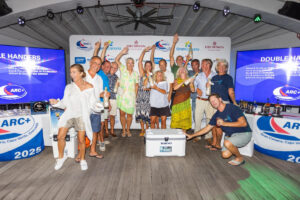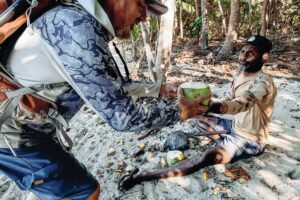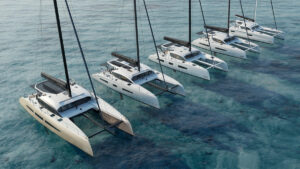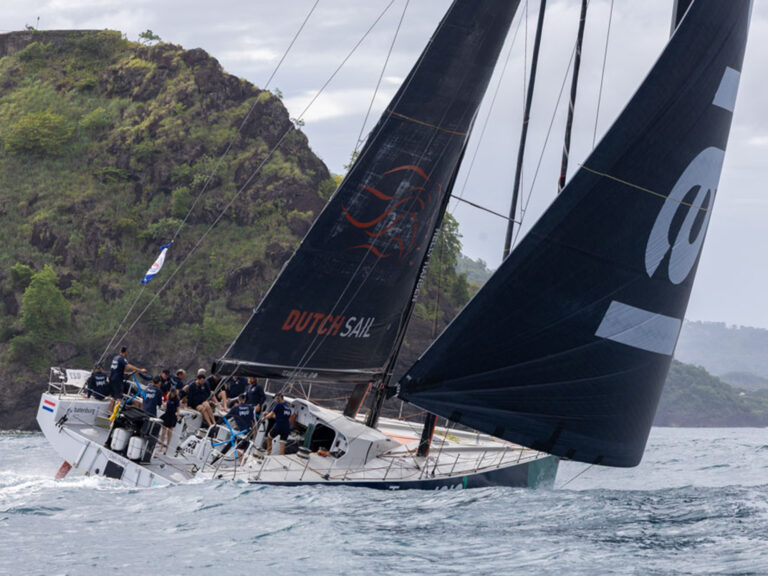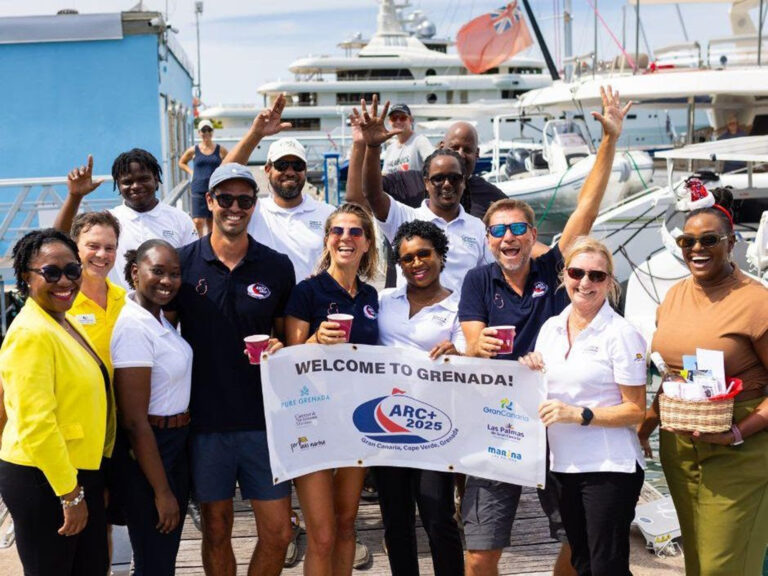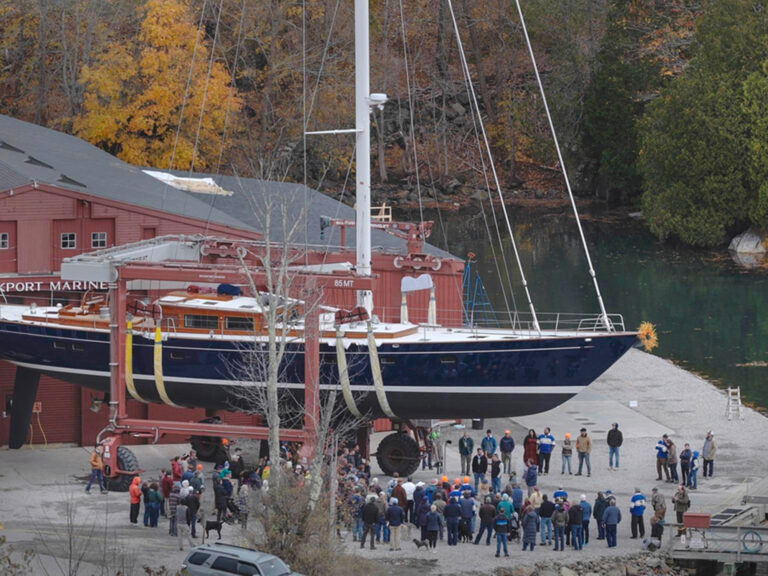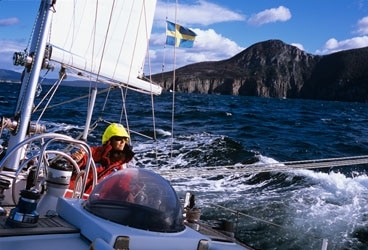
Macquarie Island 368
It’s a blustery day in Hobart, Tasmania. As we walk, Rolf and I lean into the gusts that whip around the corners of the old sandstone buildings. The wind is cool. Of course, I reflect, it’s southerly, the leading edge of a high. Simply noting the status of the weather leads my thoughts to our upcoming Southern Ocean voyage. To be honest, I think about little else. This time, however, I don’t ponder the usual lists of jobs and things yet to accomplish. As my eyes fill with wind-borne dust, the discomfort I feel makes me long to get out there. To the Southern Ocean. To the purity. To the wildness.
We’re on our way uptown, to the Tasmanian office of the Australian Bureau of Meteorology, where we’ll check the status of this year’s weather pattern. Last summer, the depressions in the Southern Ocean kept to unusually low latitudes. A result was easterly wind at Macquarie Island, the first destination of our voyage.
Easterly wind at Macquarie is unusual; generally speaking, the area is dominated by a southwesterly-to-northwesterly airstream. As the island’s only landing spots are in open bays on its eastern side, easterly wind makes visiting impossible. Last summer, neither cruise ships nor supply ships could get people ashore.
The bureau’s office is filled with rows of computer screens and busy people. The meteorologist responsible for the Southern Ocean’s high-seas forecast has four screens-one for each of the weather-prediction models available to him.
Each model has its own bias, he explains. “For example, one tends to underestimate the wind strength of a southwesterly shift,” he says. “Working with the four models over the years and being able to compare each to what really happens has led us to improved local knowledge and more accurate forecasting.” He smiles. He has good news: Last summer’s pattern hasn’t reoccurred this year. The westerlies prevail around Macquarie again. “You should still watch out for easterly wind,” he cautions. “An Australian supply ship dragged anchor and wrecked on the island a few years back when a sudden easterly shift went through.”
The three of us look at the screens. If Rolf and I leave tomorrow, as planned, we’ll have light wind and just be able to make it to an anchorage on the southern coast, 60 nautical miles from Hobart. The following morning when we put out to sea, the wind will be moderate, though not from a favorable direction. There’s nothing to actually worry about until three days later, when an intense low will pass by. The center of the depression will be well south of us, between 60 and 65 degrees south latitude. But its fronts will brush us.
“I’d keep my eye on that one,” the forecaster says. Rolf asks if there will be gale-force wind. “At least,” he answers. “Most likely strong gale-force wind, at 45 knots, or even low storm-force wind, at 50 knots.”
Walking back to the boat, Rolf treats me to a departure ice cream, and we look out from the cafe over Hobart’s glittering waterfront. “It’ll be a good start,” he says. “Decent conditions for the first three days is all we can ever ask for in this part of the world. After that, we take what we get.” He doesn’t mean to sound glib. We both consider wind above 50 knots serious business.
Into the Roaring 40s
We’ve said our good-byes to Tasmanian friends. Provisions, including three extra months of emergency supplies, are aboard. As the lines to the dock are cast off, Rolf eases back into his element and projects confidence. I feel calm, the absence of my usual nerves due to the fact that we’ve been sailing in plenty of heavy weather around Tassie in the past year. Our sailhandling routines are well greased. The Roaring 40s feel like home. And we’ve been adhering to an intense physical-training program. We’re healthy, strong, and have energy in reserve. The boat is fully serviced. Yes, we’re in the best shape we can be, and that knowledge is indeed comforting.
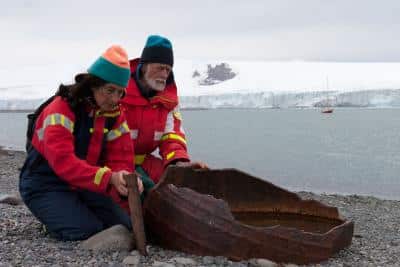
A weak southeasterly wind is blowing. With an onshore breeze, the scent of eucalyptus is supplanted by salt air. As we head for the south coast in a broad waterway, the air becomes colder, as cold as the water temperature-about 60 F. I start to shiver. On come long johns and fleece-standard apparel from now on. By the end of the passage, the temperature will drop to just above freezing.
Macquarie Island lies in the eye of the wind, 850 nautical miles away, at 54 degrees 30 minutes south and 159 degrees east. With Tasmania astern, we put Northern Light on port tack, with slack in the sheets. We make a tactical maneuver not to sail upwind and point as close as we can to the mark. Instead, we head south-southwest to skirt around the west side of the high pressure, counting on a more favorable wind angle toward Macquarie when the wind of the approaching low eventually arrives and pipes up. By afternoon, there are 12 to 15 knots of easterly wind, and when it turns to east-northeast, we ease the sheets but continue heading south. By noon the next day, we’re on course for Macquarie, with northerly wind blowing 25 to 30 knots aft of abeam. Over the first 24 hours, we log 186 nautical miles, but with the current, we cover 198 nautical miles-not bad for a 40-footer.
During the evening of the third day, the northwest wind increases to 40 knots. A southwest shift will be next. That’s the common pattern in the Southern Ocean, and we expect it to repeat many times over the next few years. At midnight, halfway through Rolf’s watch, the cold front passes, and during the change, the southwesterly wind gusts to 58 knots. The sea builds accordingly, reaching 18 to 21 feet. Tucked into the sea berth in the main cabin, I’m awakened by Rolf’s footsteps on the deck overhead. He’s walking forward, and I listen to figure out what he’s up to. I hear the main preventer’s snap shackle being unclipped from the toerail. He’s jibing.
After adjusting the slant of the sea berth, I fall back to sleep, unaware until Rolf calls to me, waking me for my watch. I dress, splash cold salt water on my face to wake up quickly, then move to my perch on the ladder under the acrylic cupola. Rolf is already in the sea berth. “The wind is 45 to 50 sustained,” he says, and I can hear how tired he is. “We’re still sailing downwind, but on starboard tack. There are three reefs in the main. The poled-out genoa is reefed to an equal size. The staysail is amidships, stabilizing, and the mizzen’s totally furled. I suggest you use a safety harness on deck.”
I don’t know how many times in the last 20 years I’ve been surprised by the sea state when looking outside for the first time during a watch. One simply doesn’t feel the sea building when lying horizontally in this boat’s angled sea berth. My night vision hasn’t adjusted fully, but I can see that there are many more white crests than when I went off watch four hours ago. I listen. The most massive of the breaking seas can be heard while still a couple of waves away. That noise gives me warning and time to brace myself. Despite the big waves-including one that poops us-Northern Light hardly yaws. The wing keel Rolf designed really keeps her on track. And the sail area is perfect. Glancing on the log, I see she’s got speed on, making nearly 8 knots. Whitewater froths and sparkles with bioluminescence to both sides, as if Northern Light is sprouting the wings required to enter the realm of the albatross.
In the Southern Ocean, where depressions typically move at 30 to 40 knots, the heaviest part of a blow usually passes us in six hours. By the end of my watch, the shriekers begin losing their edge. As the wind starts to decrease, it’s time to start unfurling some reefs to keep Northern Light going fast. She needs speed now. It gives her the momentum to stay on track while the waves are highest. Now that I’m out in the fresh air, physically active, and doing what I know needs to be done, the pressure in my chest eases a few turns too. This blow was tough. Not just because it was the first, but also because it was awaited.
Sea time to Macquarie is only four and a half days, and we average 7.8 knots. As the island rises up from a misty horizon, feelings in me rise from a deep, misty place, too. The idea for this voyage first appeared in the mid 1980s. So long ago. To flip the switch, from all the dreaming/planning/preparing to finally sighting our first southern island destination, makes us both giddy. By the time we round a shallow area that’s 150 feet deep but breaking dangerously and sheet in for the final 10 miles of our approach, we’re surrounded by thousands of petrels out from their nesting areas on Macquarie for an early morning feed. By the time we drop the hook outside the scientific station at the north end of the island, it’s 8 a.m. Our VHF radio squawks to life, and the station manager welcomes us to “Macca.” Aussies, it seems, have nicknames for everything.
Coming In for a Landing
We tuck in behind the hook called North Head, which forms the northeast corner of the island. Macquarie, only about 18 nautical miles long, has no true harbors. In terms of shelter, it’s an open roadstead. In the Southern Ocean’s belt of westerlies, so dominating that meteorologists refer to it as “the flywheel of the atmosphere,” this little land mass is pounded 99.9 percent of the time by a southwesterly swell that often curves around the head and turns into surf along the eastern coastline. Any thought of landing in a dinghy is impossible for us for the time being. The station manager commiserates. “Sorry,” he says. “We’ll keep an eye on the surf, and we’ll call you when it’s doable.”
This bay and its ugly station aren’t what we’ve come to see. A few miles south lies Sandy Bay and its king penguin colony; that’s the draw. But Macquarie is a managed reserve. And according to our permit, we’re required to land here first to be briefed on the rules. All day, gale-force winds blow. The holding seems good, but we continue our four-hour watch rotation. Rolf alternates his lookout with stitching a leather patch onto the new staysail. I bake bread and chocolate-chip cookies; the boat’s never allowed to be without either. Time passes slowly. The next morning, the weather is the same. Big waves pound the windward side of the narrow isthmus, creating a haze that wafts through our anchorage.
From 500 yards, in poor visibility, Macquarie may not look like much. But it’s a geological rarity.
A brochure from the Tasmanian Parks & Wildlife Service describes Macquarie as “the only place on Earth where midoceanic crustal rocks, all formed on or below the sea bed, are exposed at the surface.”
Macquarie has been awarded World Heritage status by the United Nations Educational, Scientific, and Cultural Organization in part for being a geological wonderland. It’s also a nature reserve. Tourists on private yachts can get permission from the Parks & Wildlife Service to visit for two days. The permit allows us to anchor at three bays but go ashore, in the company of a ranger, at just two.
When the bad weather holds, the park ranger kindly phones his boss and secures permission for us to stay an extra day. On that third day, a new low is forecast to pass through. Though not terribly deep, its center should cross right over us. The center’s position relative to ours is important. If it goes south of us, the wind stays westerly, that is, favorable. But should the low’s center pass north of us, we’ll get easterly wind and have to leave. Quickly.
We wait on tenterhooks, knocking on the barometer so often our knuckles hurt. Discussions of What If? are ongoing. On day three, just as we’ve decided that it’s not worth staying, the ranger radios to tell us that the Bureau of Meteorology has predicted that the wind will stay out of the north-between northwest to north-northeast. And he’s just been to the landing area. It’s doable. He’s lined up a crew of four, ready to change into drysuits and be in the water to assist with our landing.
I look at Rolf. He nods. I tell the ranger that we’ll inflate the dinghy and come in.
Rolf drives, zooming toward the shore while skirting patches of bull kelp, which unfortunately get larger and more tightly spaced the closer we get to shore. In the final approach, he lines up the dinghy with the cluster of people awaiting us, then judges when to speed up so we’ll ride in just behind the crest of a wave and when to put the outboard into neutral and lift it so the propeller won’t dig into the sand.
We jump out of the dinghy, and our four helpers assist us to pull the craft up the steep beach and out of the way of the next breaker. Whew.
Landfall: Macca
We’re surrounded by smiling faces. Always a bit tongue-tied when we go from being alone to being with new people, we let them do the talking. The scientists and support crew say they’ve been feeling badly for us, “sitting out there like prisoners, rolling and rolling.” The ranger briefs us on the rules, then hands us over to his colleague who’s to accompany us ashore. Our guide, a biologist who’s been working on Macca for several seasons, is a wealth of knowledge.
Nearby we see molting elephant seals clustered together in piles. The guide says there are 10,000 southern elephant seals lying in similar piles around the island. Why piles? Well, he says, although an elephant seal’s blood usually doesn’t penetrate the outermost layer of blubber, it must do so to facilitate molting. That chills the seal; the group pile is a way for them to remain warm. He adds that Macquarie’s elephant-seal population has been decreasing over the last 40 years.
We walk along the beach, then cut over to the west side of the isthmus. Our guide explains everything that’s happening around us. The sky is heavily overcast-that’s the norm for a high-latitude maritime climate. The island’s upper plateau is shrouded in cloud and mist, as it often is for days on end. It’s drizzling-normal conditions for 300 days of the year-and only a few degrees above freezing. The norm for January is in the 40s F, but the temperature can drop below freezing, and it can snow on any day of the year. Wind gusts over 70 knots have been recorded in every month. Today’s relative humidity is 95 percent. It’s like this only a third of the days of the year; 85 percent is more common. He continues with more facts, but my attention’s diverted.
There they are. What I’ve longed to see for so many years: king penguins! Shivers of excitement run along my spine. About 20 silent kings stand in a huddle on the black stone beach at the water’s edge. The guide leads us toward them slowly. In the gray light, their orange neck feathers seem to glow. We sit, becoming the height of a king penguin. Rolf and I want just to stay near the group and observe while smelling the beached kelp and the salty tide pools. But the pleasure isn’t to be ours.
Always remaining on alert for any change in the weather is a matter of survival in these waters. Rolf and I have both been keeping a weather eye-the Bureau of Meteorology’s prediction is a forecast, not a promise. The wind shifts a bit to the east of north. Time to go?
My adrenalin starts flowing. We watch the station’s flag. The wind lightens. Then shifts back. But despite the favorable change, Northern Light bucks and rolls even more than before. The swell has increased. The process of getting the dinghy and 15-horse outboard on deck and stowed below for the passage is difficult when the motion is this violent. We can’t risk it getting worse. We thank our guide, ask him to relay our greetings to the rest of the gang, and jog to the dinghy. Back aboard Northern Light, we get everything stowed and eat lunch.
The wind and swell diminish. I radio the ranger, who says, “It’s not a problem if you want to come ashore again.” We pull out the dinghy, reinflate it, put on the outboard, and back in we go. The sun peeks between clouds, and we wander around for an hour, looking at the utterly magnificent kings, a smattering of gentoo penguins, some giant petrels, skuas, and more piles of elephant seals.
At the end of our wander, we visit the station for a “cuppa” and a chat with scientists and station staff. Everyone’s so interesting. The big news is a pest-eradication project. In their wake, sealers left behind cats, rabbits, rats, and mice. Millions are now being spent to rid the island of the nonindigenous species, thereby giving the flora and fauna a chance to recover.
Relishing the Present
Too soon, it’s time for us to return to Northern Light, pack things again, and eat dinner. With everything shipshape and a cup of tea in hand, Rolf gazes out a porthole toward the south. Only 10 nautical miles in that direction lies a colony of 20,000 kings. A little farther are colonies of endemic royal penguins and rockhopper penguins. But our one-day extension is up. We won’t get to see them.
It’s too bad, but we’re not disappointed. Intentionally, neither of us has cultivated major expectations for visits to any of the islands ringing Antarctica. Weather and wind, as well as the state of the boat and our health, will ultimately determine how many islands we sight and how many we visit. We feel lucky to have been ashore on Macca.
Under sail, the little to be seen of the island disappears quickly into the cold mist. While Rolf trims and I set the wind steering, an albatross circles Northern Light three times, then flies off in the direction of Auckland Island, our next landfall. The majestic wanderer is a reminder that wilderness experiences await us all of the way there.
Click here to read more installments of Pearls Around the White Continent.
In an upcoming issue of CW, read more about the epic voyage of Deborah Shapiro and Rolf Bjelke to the Southern Ocean as they sail to the Auckland Islands and to Campbell Island and have close encounters of the animal kind. You can contact them at info@northernlightsail.se.

